|
Airspeed A.S.51 Horsa Glider
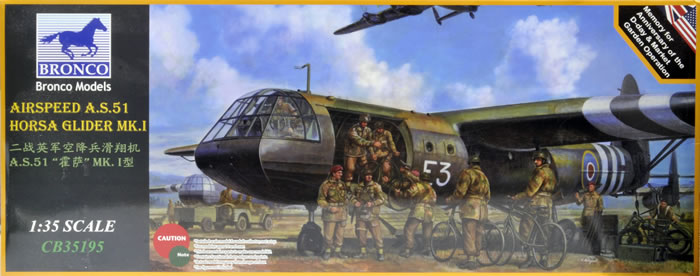
Bronco Models, 1/35 scale
S
u m m a r y |
| Description and Catalogue Number: |
Bronco Models Kit No. CB-35195 - Airspeed A.S.51 Horsa Glider |
| Scale: |
1/35 |
| Contents and Media: |
289 parts in light grey plastic, 16 parts in clear, eleven parts on a single photo-etched fret, self-adhesive canopy masks, a metal nose weight and markings for three aircraft. |
| Price: |
£91.66 (Export Price) or £109.99 (EU Price) plus shipping available online from Hannants
USD$116.99 plus shipping available online from Lucky Model |
| Review Type: |
FirstLook |
| Advantages: |
High level of detail; many useful options; amazingly versatile diorama subject; serious "wow" factor. |
| Disadvantages: |
Questions about roundel colours and proportions. |
| Conclusion: |
Bronco’s 1:35 scale Horsa is a large and ambitious kit that will appeal to both aircraft and armour modellers. Considering Bronco’s obsession with all things Airborne lately – jeeps, bikes, artillery, figures, accessories – there is certainly no shortage of diorama potential. The parts count is actually pretty modest considering the size and completeness of this model, and it should be suitable for anyone with moderate modelling experience. Highly recommended and a big “wow” factor! |
Reviewed by Brett Green

Bronco's 1/35 scale Horsa will be available online from Squadron.com
The Airspeed AS.51 Horsa was a British World War II troop-carrying glider built by Airspeed Limited and subcontractors and used for air assault by British and Allied armed forces. It was named after Horsa, the legendary 5th-century conqueror of southern Britain.
Production of the Horsa commenced in early 1942, and by May some 2,345 had been ordered by the Army for use in future airborne operations. The glider was designed from the outset to be built in components with a series of 30 sub-assemblies required to complete the manufacturing process. Manufacturing was intended primarily to use woodcrafting facilities not needed for more urgent aviation production, and as a result production was spread across separate factories, which consequently limited the likely loss in case of German attack. The designer A. H. Tiltman said that the Horsa "went from the drawing board to the air in ten months, which was not too bad considering the drawings had to be made suitable for the furniture trade who were responsible for all production."
The Horsa Mk.I had a wingspan of 88 feet (27 m) and a length of 67 feet (20 m), and when fully loaded weighed 15,250 pounds (6,920 kg).
The Horsa was considered sturdy and very manoeuvrable for a glider. Its design was based on a high-wing cantilever monoplane with wooden wings and a wooden semi-monocoque fuselage. The fuselage was built in three sections bolted together, the front section held the pilot's compartment and main freight loading door, the middle section was accommodation for troops or freight, the rear section supported the tail unit. It had a fixed tricycle landing gear and it was one of the first gliders equipped with a tricycle undercarriage for take off. On operational flights the main gear could be jettisoned and landing was then made on the castoring nose wheel and a sprung skid under the fuselage
With up to 30 troop seats, the Horsa was much bigger than the 13-troop American Waco CG-4A (known as the Hadrian by the British), and the 8-troop General Aircraft Hotspur glider which was intended for training duties only. Instead of troops, the AS 51 could carry a jeep or a 6 pounder anti tank gun.
On operations, the Horsa was towed by various aircraft: four engined heavy bombers displaced from operational service such as the Short Stirling and Handley Page Halifax, the Armstrong Whitworth Albemarle and Armstrong Whitworth Whitley twin engined bombers, as well as the US Douglas C-47 Skytrain/Dakota (not as often due to the weight of the glider, however in Operation Market Garden, a total of 1,336 C-47s along with 340 Stirlings were employed to tow 1,205 gliders) and Curtiss C-46 Commando. They were towed with a harness that attached to points on both wings, and also carried an intercom between tug and glider. The glider pilots were usually from the Glider Pilot Regiment, part of the Army Air Corps, although Royal Air Force pilots were used on occasion.
The United States Army Air Forces (USAAF) acquired approximately 400 Horsas in a form of "reverse" Lend-Lease.*
Bronco has finally released their much anticipated 1:35 scale Airspeed Horsa Mk.I.
This is a big model in a big box. When completed, the wing span will be nearly 30”, with a fuselage length of around 23”.
The model comprises 289 parts in light grey plastic, 16 parts in clear, eleven parts on a single photo-etched fret, self-adhesive canopy masks, a metal nose weight and markings for three aircraft.
When exploring the contents of the box, it feels like there are more than 289 plastic parts. I think this is because many of these parts are quite large.
The fuselage is broken down into nose, forward fuselage and rear fuselage sub-assemblies; while the wings are made up from a stout centre upper saddle and upper and lower halves for each wing. All control surfaces are separate.

The cockpit reflects the simple layout of the real aircraft, and harness straps are supplied on the kit’s photo-etched fret.
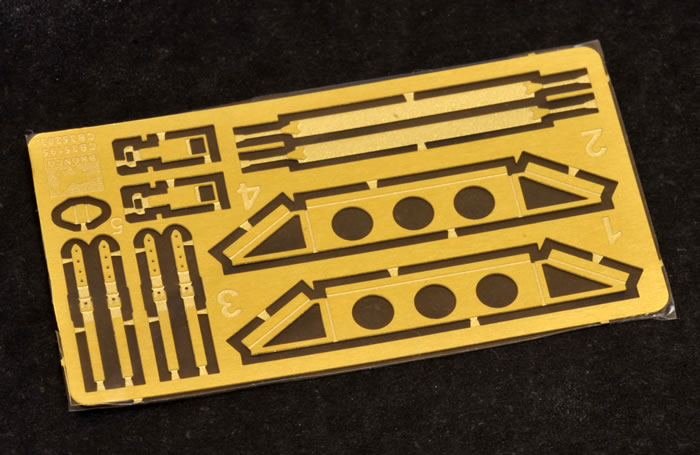
Decals are supplied for dials and placards on the small instrument panel.
The large windscreen is thin and crystal clear.
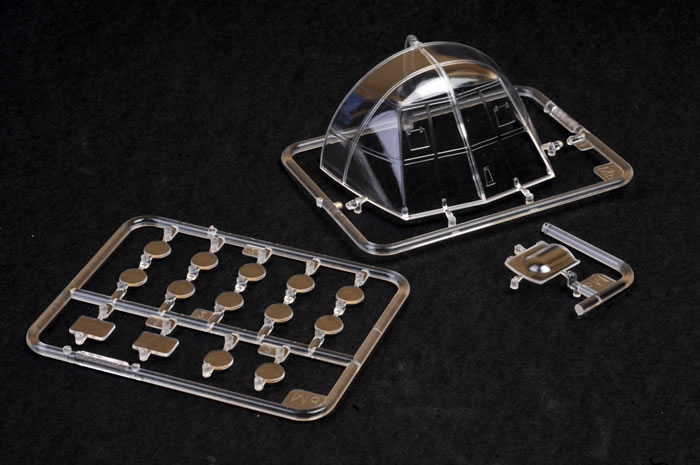
Self-adhesive masks are provided for both the inside and outside of the windscreen.

The main fuselage sub-assemblies are built up in layers from the inside out. Bulkheads are attached to the ribbed floors, followed by stringers at the top of the bulkheads and other details including troop benches and their mounts. The benches have harness straps moulded in place. Please note that if you plan to load a jeep into the fuselage, you should omit the benches.
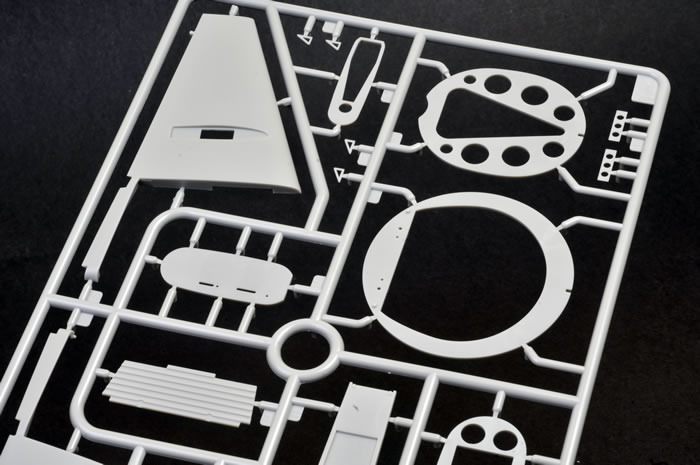
The loading ramp may be posed open and closed, with a few additional options for the open ramp including photo-etched channels for your 1:35 scale jeep. Legs or a wedge are provided for the open ramp too.
If the ramp is closed, you still have the option to pose the smaller entry hatch open. A ladder is supplied for this configuration.
The fuselage exterior is applied in panels as a skin around the structural frame. The fuselage and wing surfaces are correctly featureless, reflecting the plywood construction of the airframe.
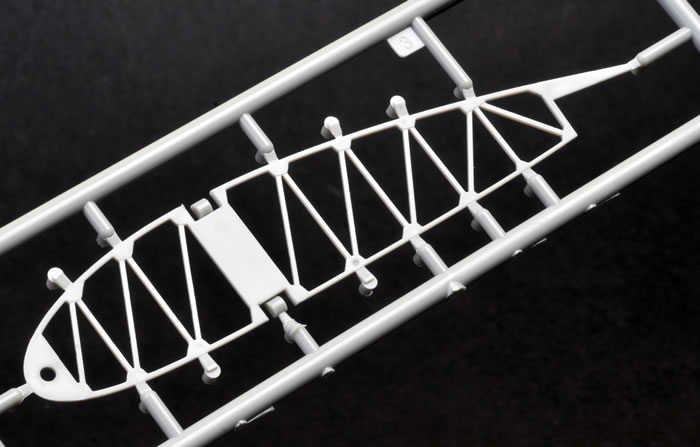
Elevators and rudders are moveable, while flaps and ailerons are fixed. The flaps may be posed open (dropped) or closed.
A metal nose weight is also provided.

Markings
Decals are supplied for two RAF aircraft and one USAAF. All three are relevant to the Normandy campaign on 6 June 1944. The decals are well printed but the red and yellow are definitely too bright, and the proportions of the fuselage C type roundels look odd to me.

Full colour four-view diagrams are included for all three subjects, including helpful notes on the width of the invasion stripes in 1:35 scale (they’re 113mm wide each if you’re curious).
Strangely, the upper surface colours are called out as Dark Green and Dark Yellow. It should be Dark Green and Dark Earth.
Bronco’s 1:35 scale Horsa is a large and ambitious kit that will appeal to both aircraft and armour modellers. Considering Bronco’s obsession with all things Airborne lately – jeeps, bikes, artillery, figures, accessories – there is certainly no shortage of diorama potential.
The parts count is actually pretty modest considering the size and completeness of this model, and it should be suitable for anyone with moderate modelling experience.
Highly recommended and a big “wow” factor!
Highly Recommended.
Thanks to Bronco for the sample www.cn-bronco.com
Text and Images Copyright © 2015 by Brett Green
Page Created 3 November, 2015
Last updated
3 November, 2015
Back to HyperScale Main Page |
